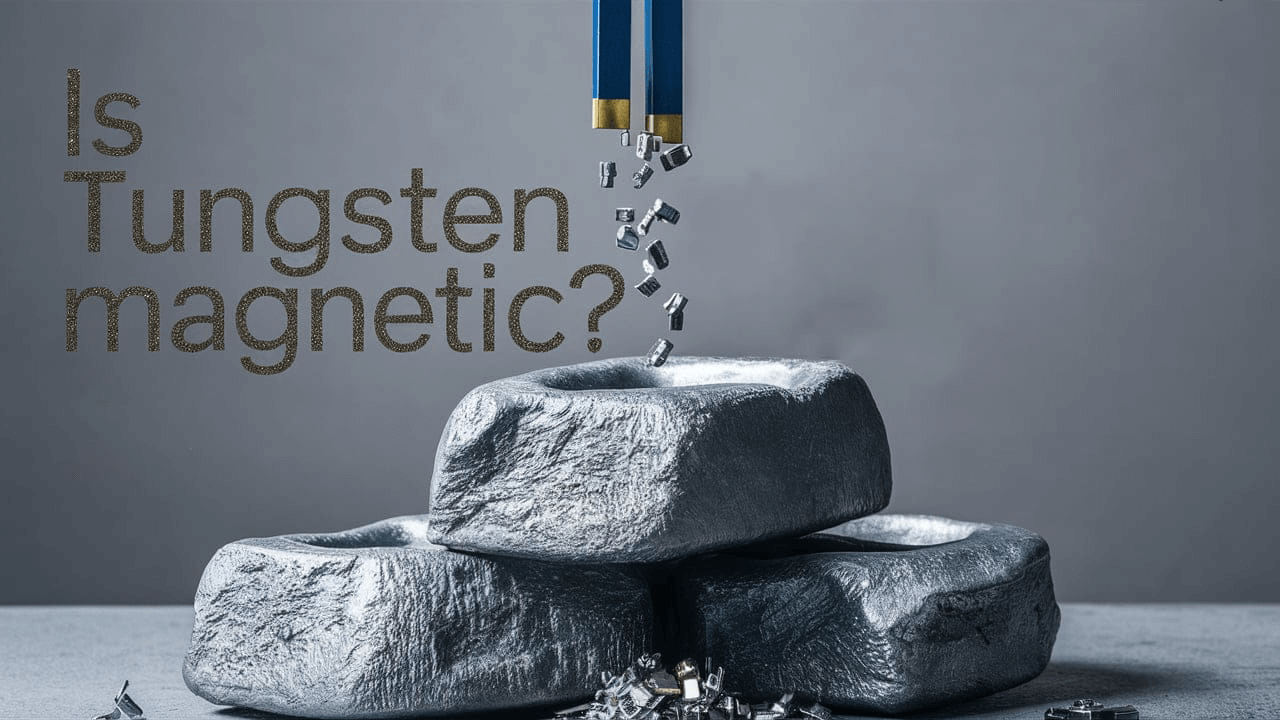1. Introduction: The Relationship Between Magnetism and Metals
Magnetism is a fundamental concept in material science, playing a critical role in various industrial and technological applications. While many associate magnetism with metals like iron, not all metals exhibit magnetic properties. Understanding which metals are magnetic, non-magnetic, or weakly magnetic is crucial for applications in aerospace, electronics, and medical technologies. This article explores the magnetic properties of refractory metals such as tungsten and titanium, addressing questions like “Does tungsten have magnetic properties?” and “Can titanium be magnetized?”
2. Which Metals Are Non-Magnetic?
Many metals, despite their excellent conductivity and strength, do not exhibit significant magnetic properties. These metals are often used in environments where magnetic interference must be avoided, or in structural applications where non-magnetic materials are preferred.
Common Non-Magnetic Metals:
| Metal | Magnetic Properties | Typical Applications |
|---|---|---|
| Titanium | Non-magnetic | Aerospace, medical |
| Gold | Non-magnetic | Jewelry, electronic components |
| Copper | Non-magnetic | Cables, electronic devices |
| Silver | Non-magnetic | Electrical connectors, ornaments |
| Aluminum | Non-magnetic | Aerospace, electronics |
| Lead | Non-magnetic | Radiation shielding, construction |
These metals generally exhibit diamagnetism (such as gold and copper) or paramagnetism (such as titanium). Diamagnetic metals show a slight repulsive effect in a magnetic field, while paramagnetic metals experience a weak attraction, but they do not retain magnetism once the magnetic field is removed.
3. Does Tungsten Have Magnetic Properties?
Tungsten is known for its high melting point and density, making it useful in high-performance applications. However, pure tungsten does not exhibit magnetic properties.
Magnetic Properties of Tungsten:
Tungsten is classified as a diamagnetic metal, meaning it exhibits a very weak repulsion to magnetic fields. This effect is so weak that it is generally undetectable in practical applications. Tungsten’s atomic structure and electron configuration prevent it from forming magnetic properties like those of ferromagnetic metals such as iron.
Can Tungsten Be Magnetized?
Although pure tungsten does not possess magnetic properties, tungsten alloys can exhibit magnetic properties when combined with ferromagnetic metals like iron, cobalt, or nickel. Therefore, while pure tungsten itself remains non-magnetic, it is possible for certain tungsten alloys to display magnetic features.

4. Does Titanium Have Magnetic Properties?
Titanium is generally considered non-magnetic, but its response to a magnetic field is slightly different.
Magnetic Properties of Titanium:
Titanium is classified as a paramagnetic metal, meaning it exhibits weak attraction to magnetic fields, but unlike ferromagnetic metals, it does not retain any magnetic properties once the magnetic field is removed. The electron configuration of titanium prevents it from forming a strong magnetic effect.
Can Titanium Be Magnetized?
Although titanium’s magnetic properties are very weak, its attraction may increase in strong magnetic fields. However, it will not permanently retain magnetism. Therefore, titanium is considered non-magnetic for most practical applications and will not interfere with magnetic devices.
5. Magnetic Properties of Refractory Metals
Refractory metals, such as tungsten, molybdenum, and tantalum, are known for their extremely high melting points, strength, and corrosion resistance. While these metals have unique physical properties, most refractory metals do not exhibit significant magnetic properties.
Why Are Refractory Metals Typically Non-Magnetic?
The crystal structures and electron configurations of these metals prevent their free electrons from aligning in an external magnetic field, preventing them from generating significant magnetic properties. Even tungsten, despite its hardness and density, does not exhibit ferromagnetism.
Industrial Applications of Refractory Metals:
Refractory metals are widely used in environments where extreme temperatures are involved. In these situations, magnetism is typically not a critical factor. For example, in the aerospace industry, tungsten and molybdenum are used for their density and strength, but their non-magnetic properties help avoid interference with sensitive equipment.
6. How Can Tungsten Be Made Magnetic?
While tungsten itself does not possess magnetic properties, it can be alloyed with other ferromagnetic metals like iron, cobalt, or nickel to form magnetic composite materials.
The Process of Magnetizing Tungsten:
- Alloying Tungsten: By combining tungsten with ferromagnetic metals, it is possible to create alloys that exhibit magnetic properties.
- External Influence: In extreme magnetic fields or temperatures, tungsten’s magnetic response may temporarily change, but this does not alter its intrinsic non-magnetic nature.
7. Applications and Implications of Non-Magnetic Metals
Non-magnetic metals like titanium and tungsten are widely used in various industries, especially in applications where magnetic interference needs to be avoided or where non-magnetic properties are required.
Key Application Areas:
| Industry | Typical Applications | Advantages of Non-Magnetic Metals |
|---|---|---|
| Aerospace | Aircraft exteriors, engine components | Avoids magnetic interference, lightweight and strong |
| Medical Devices | Surgical instruments, implants | Titanium’s corrosion resistance and non-magnetic properties, suitable for long-term implants |
| Electronics | Electronic components, connectors | Non-magnetic properties prevent interference with electronic devices |
These metals offer superior performance in environments where avoiding magnetic interference is crucial, such as in MRI imaging or high-precision devices in aerospace.
8. Conclusion
From the discussion above, we can conclude that tungsten and titanium are generally non-magnetic. Tungsten is a diamagnetic metal, while titanium is paramagnetic. Though they may exhibit weak magnetic effects under extreme conditions, they are typically considered non-magnetic in most practical applications. Understanding the magnetic properties of these metals is essential when selecting materials for various industries, especially those that require high precision or where magnetic interference must be minimized.
